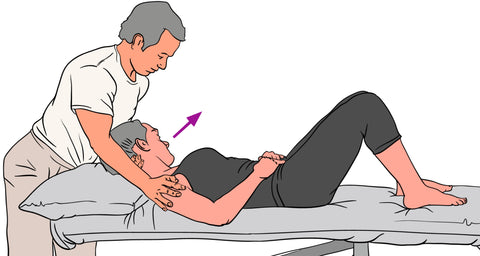Muscle Energy Technique - Levator Scapulae
Levator Scapulae - Trigger Point Anatomy
MET's are sometimes used by therapists in combination with trigger point therapy protocols
Muscle Energy Techniques (MET's) emerged as a form of osteopathic manipulative diagnosis and treatment in which the client's muscles are actively used on request, from a precisely controlled position, in a specific direction, and against a distinctly executed counterforce from the practitioner.
MET Treatment for Levator Scapulae
For this treatment the client is supine. The therapist, while providing support, guides the client's head into a side bend, followed by flexion.
If a resistance is felt prior to the chin touching the chest, this indicates relative shortness of the levator scapulae.
Some therapists find it more appropriate to treat the levator scapulae from the test position (shown at the end of this blog), rather than placing the patient in an alternative position.
It will be a matter of choice, but it is generally more comfortable to treat the levator scapulae from the supine position.
There are certain times when the client is unable to adopt a supine position, as this can cause discomfort, for example those who present with cervical spine pain.
In this case the seated position would be more appropriate for an MET treatment.

Position for MET treatment of levator scapulae
From the position of bind, the client is asked to push their cervical spine into extension to initiate the contraction of the levator scapulae.
After the appropriate time and on the relaxation, the client's cervical spine is taken into further flexion, with an added left rotational movement (as shown in the illustration below).

The cervical spine is encouraged into further flexion to lengthen the right levator scapulae. The chin is taken towards the chest, with the therapist stabilising the right scapula.
Note: The levator scapula is working in an eccentric contraction when the cervical position is held in a forward head posture; this indicates that the muscle is in a lengthened position but still in a contracted state.
The client may experience pain at the insertion of the levator scapulae on the superior angle of the scapulae.
If this is the case, an MET to lengthen an already lengthened structure might not be appropriate.
Common Testing Method
One common method of testing the levator scapulae is from the seated position shown in the illustration below.
The therapist gently assists the motion of the head and controls the cervical spine into approximately 30 degrees of right rotation.
Once the cervical spine is in the position of rotation, the therapist then encourages cervical flexion and will try to approximate the client's chin onto their chest.
The therapist’s right hand prevents the scapula from elevating. When the therapist feels a bind, the range of motion is noted.
If the chin can approximate the chest with no resistance, the levator scapulae is generally classified as normal.

Find a Trigger Point Professional in your area
Dry Needling for Trigger Points
Certify as a Trigger Point Therapist

This trigger point therapy blog is intended to be used for information purposes only and is not intended to be used for medical diagnosis or treatment or to substitute for a medical diagnosis and/or treatment rendered or prescribed by a physician or competent healthcare professional. This information is designed as educational material, but should not be taken as a recommendation for treatment of any particular person or patient. Always consult your physician if you think you need treatment or if you feel unwell.
Disclaimer
The information in this article is intended for educational purposes within the context of continuing education for massage therapists, continuing education for athletic trainers, continuing education for physical therapists, continuing education for chiropractors, and continuing education for rehabilitation professionals. It is not a substitute for medical advice, diagnosis, or treatment. Although every effort has been made to ensure accuracy and reflect current understanding at the time of publication, practitioners must always work within the legal scope of their professional practice and follow all regional regulatory guidelines.
Hands-on techniques and clinical applications described in this material should only be performed by appropriately trained and licensed professionals. Individuals experiencing pain or symptoms should be referred to a qualified healthcare provider for assessment. Niel Asher Education is not responsible for any injury, loss, or damage resulting from the use or misuse of the information provided in this content.

Continuing Professional Education
Looking for Massage Therapy CEUs, PT and ATC continuing education, chiropractic CE, or advanced manual therapy training? Explore our evidence-based online courses designed for hands-on professionals.



















